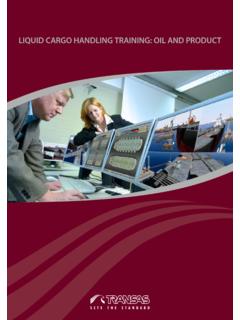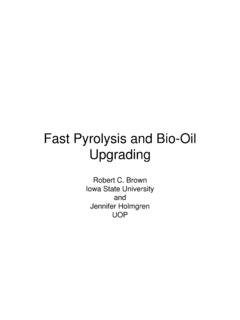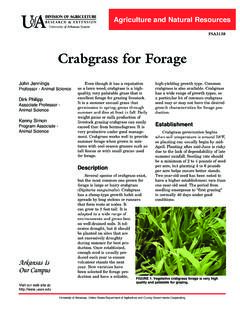Transcription of Large-Scale Pyrolysis Oil Technical Report
1 A national laboratory of the Department of Energy Office of Energy Efficiency & Renewable Energy National Renewable Energy Laboratory Innovation for Our Energy Future Technical Report Large-Scale Pyrolysis Oil NREL/TP-510-37779 Production: A Technology November 2006 Assessment and Economic Analysis M. Ringer, V. Putsche, and J. Scahill NREL is operated by Midwest Research Institute Battelle Contract No. DE-AC36-99-GO10337 Technical ReportNREL/TP-510-37779 November 2006 Large-Scale Pyrolysis Oil Production: A TechnologyAssessment and Economic Analysis M. Ringer, V. Putsche, and J. Scahill Prepared under Task No. National Renewable Energy Laboratory1617 Cole Boulevard, Golden, Colorado 80401-3393 303-275-3000 for the Department of EnergyOffice of Energy Efficiency and Renewable EnergybyMidwest Research Institute Battelle Contract No.
2 DE-AC36-99-GO10337 NOTICEThis Report was prepared as an account ofwork sponsored by an agency of the United States government. Neither the United States government nor any agency thereof, nor any of their employees, makes any warranty, express or implied, orassumes any legal liability or responsibility for the accuracy, completeness, orusefulness of any information, apparatus, product, orprocess disclosed, or represents that its use would not infringe privately owned rights. Reference herein to any specific commercial product, process, or service bytrade name, trademark, manufacturer, or otherwise does not necessarily constitute or imply its endorsement,recommendation, or favoring by the United Statesgovernment or any agency thereof.
3 The views andopinions of authors expressed herein do not necessarily state or reflect those of the United Statesgovernment or any agency thereof. Available electronically at for a processing fee to Department of Energyand itscontractors, in paper, from: Department of EnergyOffice of Scientific and Technical Information Box 62 Oak Ridge, TN 37831-0062phone: fax: email: forsale to the public, in paper, from: Department of Commerce National Technical Information Service 5285 Port Royal Road Springfield, VA 22161 phone: fax: email: ordering: on paper containing 100% postconsumer waste Executive Summary Pyrolysis is one of a number of possible paths for converting biomass to higher value products.
4 As such, this technology can play a role in a biorefinery model to expand the suite of product options available from biomass. The intent of this Report is to provide the reader with a broad perspective of Pyrolysis technology as it relates to converting biomass substrates to a liquid bio oil product, and a detailed Technical and economic assessment of a fast Pyrolysis plant producing 16 tonne/day of bio-oil. The international research community has developed a considerable body of knowledge on the topic over the last twenty-five years. The first part of this Report attempts to synthesize much of this information into the relevant issues that are important to advancing Pyrolysis technology to commercialization.
5 The most relevant topics fall under the following categories: 1) Technical requirements for converting biomass to high yields of liquid bio-oil 2) Reactor designs capable of meeting Technical requirements 3) Bio-oil stability issues and recent findings that address the problem 4) Product specifications and standards that need to be established 5) Applications for using bio-oil in existing or modified end use devices 6) Environmental, safety, and health issues For the bio-oil plant Technical and economic analysis, the process is based on fast Pyrolysis , which is composed of five major processing areas: feed handling and drying, Pyrolysis , char combustion, product recovery, and steam generation.
6 An ASPEN model was developed to simulate the operation of the bio-oil production plant. Based on a 550 tonne/day biomass (wood chips, 50% by mass water content) feed, the cost of the bio-oil for a fully equity financed plant and 10% internal rate of return is $ on a lower heating value (LHV) basis. i Table of Contents Executive 1. 1 2. Production of Bio-oil .. 5 Heat Transfer Requirements .. 5 Biomass Feedstock Preparation .. 6 Reactor Designs Capable of Achieving Fast Pyrolysis 7 Bubbling Fluidized Bed .. 8 Circulating Fluidizing 9 Ablative 11 Vacuum Pyrolysis .
7 12 Rotating Cone Pyrolysis 13 Pyrolysis Vapor (Bio-oil) Recovery .. 13 Char and Particulate 14 3. Properties of 16 Chemical Nature of 16 Physical Properties of Bio-oil (Stability).. 19 Physical Properties (Re-vaporization) .. 20 Environmental / 21 4. Uses for 23 23 Diesel Engines .. 23 Combustion 24 Bio-Oil Standards and Specifications .. 25 Upgrading Bio-oil Properties to Higher Value Products .. 27 5. Prior Investigations of Bio-Oil Production Costs .. 29 6. Wood Chip Pyrolysis Facility Economic 31 Design Basis and Process 31 Model Description.
8 35 Material and Energy Balance 36 Economic 36 Capital Costs .. 37 ii iii Operating 37 Economic Analysis ..38 Capital Cost Operating Cost Results ..41 Financial Analysis Results ..41 Discussion ..41 Sensitivity 42 Upgrading of Crude Bio-Oil ..43 Limitations of the Analysis ..44 7. Conclusions and Recommendations ..45 Current State-of-the-Art for Fast Pyrolysis of Biomass ..45 Recommendations for Advancing Fast Pyrolysis Appendix A: ASPEN Plus Model Implementation / Mass Balances ..57 List of Figures Figure 1.
9 Process Schematic for a Bubbling Fluidized Bed Pyrolysis Design ..9 Figure 2. Process Schematic for a Circulating Fluidized Bed Pyrolysis Design ..10 Figure 3. Schematic of the NREL Vortex Reactor Fast Pyrolysis Reactor Design ..11 Figure 4. Molecular Beam Mass Spectrometer Scans of Pyrolysis Product Profile at Different Temperatures Using the Same Pine Wood Sample ..18 Figure 5. Fast Pyrolysis Block Flow Figure 6. Proposed Heavy Bio-Oil Upgrading Process ..43 Figure 7. Bio-Oil Production and Upgrading Cost List of Tables Table 1. Worldwide Biomass Pyrolysis Units ..3 Table 2. Properties of Bio-oil from Various Feedstocks ..17 Table 3. Proposed Specifications for Various Grades of Table 4.
10 Bio-oil Production Cost/Selling Table 5. Design Basis ..33 Table 6. Total Project Investment Factors .. 37 Table 7. Unit Costs .. 38 Table 8. Employee 38 Table 9. Installed Equipment Costs .. 40 Table 10. Total Project 41 Table 11. Crude Bio-oil Sensitivity Studies .. 43 Table 12. Worldwide Current Biomass Pyrolysis Operating 47 iv 1. Introduction The vast stores of biomass available in the domestic United States have the potential to displace significant amounts of fuels that are currently derived from petroleum sources. Energy security, energy flexibility, and rural and urban job development are other drivers that support the use of biomass to produce fuels, chemicals, and other products.
















